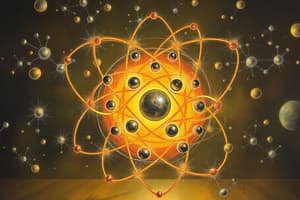Podcast
Questions and Answers
What determines the pattern of electron shells in an atom?
What determines the pattern of electron shells in an atom?
- Number of neutrons
- Atomic mass
- Number of protons
- Atomic number (correct)
In covalent bonds, atoms bond together by __________.
In covalent bonds, atoms bond together by __________.
- Losing electrons
- Transferring electrons
- Gaining protons
- Sharing electrons (correct)
What type of bond occurs when electrons are transferred from one atom to another?
What type of bond occurs when electrons are transferred from one atom to another?
- Hydrogen bond
- Metallic bond
- Ionic bond (correct)
- Covalent bond
Flashcards are hidden until you start studying
Study Notes
Unraveling Atomic Structure: A Peek at the Building Blocks of Matter
The field of chemistry is a quest to understand the world around us, from the simple compounds in our daily lives to the intricate workings of the human body. At its core, chemistry is the study of atoms and the way they bond together—an investigation that begins with the marvelous atomic structure of matter. Here, we'll explore the fundamental building blocks of chemistry, the elements, and their arrangement in atoms and molecules.
Atoms: The Elemental Building Blocks
Atoms are the smallest unit of a chemical element that can exist independently and still retain the characteristic properties of that element. They are composed of three main subatomic particles: protons, neutrons, and electrons.
- Protons are positively charged particles found in the nucleus of an atom. They determine the element's identity through their atomic number, which represents the number of protons in the nucleus.
- Neutrons are uncharged particles also found in the nucleus. They have no charge and are primarily responsible for the atom's mass.
- Electrons are negatively charged particles that orbit the nucleus in energy levels known as electron shells or electron orbitals.
Atomic Structure
Atomic structure is the organization and arrangement of protons, neutrons, and electrons in an atom. The nucleus, which contains almost all of the atom's mass, is composed of protons and neutrons. The electrons, which have a nearly negligible mass, orbit the nucleus in distinct energy levels or shells.
The pattern of electron shells in an atom is determined by the element's atomic number. The periodic table, a chart that arranges elements based on their atomic number, organizes elements into groups with similar chemical properties due to the identical outermost electron shells.
Bonding: Building Molecules
When atoms bond together, they form molecules, which are the fundamental units of many chemical compounds. Atoms can bond through the sharing or transfer of electrons, resulting in covalent or ionic bonds, respectively.
- Covalent bonds occur when atoms share electrons to achieve a stable electron configuration.
- Ionic bonds occur when electrons are transferred from one atom to another, creating a charged ion and an opposite charge in the neighboring atom.
The formation of bonds between atoms is responsible for the properties of molecules and the compounds they form.
Applications of Atomic Structure
Understanding atomic structure has led to countless technological advancements, including nuclear power, medicine, and materials science. The periodic table, with its organization of elements based on atomic structure, has allowed chemists to predict the properties of new elements and compounds, leading to the discovery of many previously unknown chemical elements and materials.
As we continue to decipher the intricate dance of protons, neutrons, and electrons, we will undoubtedly uncover more insights into the inner workings of our universe, from the smallest of atoms to the cosmos itself.
Studying That Suits You
Use AI to generate personalized quizzes and flashcards to suit your learning preferences.



